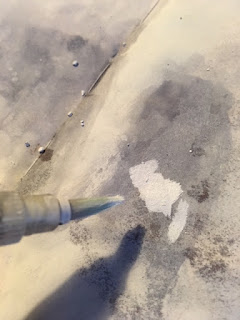The finished piece was spraymounted on to thin particle board that was then glued to several additional layers of board cut on a bandsaw. The final piece was then painted black along the exposed surfaces and edges and given a hanging wire via two screws in the back. The finished work was exhibited in the Cosmos show at Syzygy SF this year.
Friday, March 22, 2019
Voluptaris
The finished piece was spraymounted on to thin particle board that was then glued to several additional layers of board cut on a bandsaw. The final piece was then painted black along the exposed surfaces and edges and given a hanging wire via two screws in the back. The finished work was exhibited in the Cosmos show at Syzygy SF this year.
Monday, November 26, 2018
Resurrecting the White
The Dilemma
I've been walking around with a small jar of Kuretake White Ink 30 (30 ml) for well over a year. Unfortunatley, the batch had dried to a chalky, brittle consistency and I was very close to throwing out the remaining 1/3 of ink. A minute or so of vigorous scrubbing seemed to release enough pigment for moderate coverage or blending with another inks or watercolors but the original full opacity was no longer an option.
I tried using a water-vinegar mix to dissolve the dried ink, but it didn't seem to be doing much. A few shards began to slide off of the edges like tiny ice sheets, but the solid mass below would not budge. After a few minutes of thinking, I thought increasing the surface area of the dried mass night help the solvent solution do its job. After poking and digging at it with the square end of an X-acto knife blade, I made an interesting discovery.
The Discovery
To my surprise, the blob rolled over and revealed a soft underside with a consistency similar to when I first opened the jar about a year ago. I tested a few strokes with a brush in one of my sketchbooks and the coverage was fantastic.
Conclusion
I guess a "skin" developed over the ink after repeatedly exposing the top layer to air. That, and a general lack of stirring may have contributed to the drying. I doubt that my water-vinegar formula had much of an impact. The ink, I believe, had in fact preserved itself. I look forward to finishing off this jar and investing in a fresh one, hopefully before the year is out.
I've been walking around with a small jar of Kuretake White Ink 30 (30 ml) for well over a year. Unfortunatley, the batch had dried to a chalky, brittle consistency and I was very close to throwing out the remaining 1/3 of ink. A minute or so of vigorous scrubbing seemed to release enough pigment for moderate coverage or blending with another inks or watercolors but the original full opacity was no longer an option.
I tried using a water-vinegar mix to dissolve the dried ink, but it didn't seem to be doing much. A few shards began to slide off of the edges like tiny ice sheets, but the solid mass below would not budge. After a few minutes of thinking, I thought increasing the surface area of the dried mass night help the solvent solution do its job. After poking and digging at it with the square end of an X-acto knife blade, I made an interesting discovery.
The Discovery
To my surprise, the blob rolled over and revealed a soft underside with a consistency similar to when I first opened the jar about a year ago. I tested a few strokes with a brush in one of my sketchbooks and the coverage was fantastic.
Conclusion
I guess a "skin" developed over the ink after repeatedly exposing the top layer to air. That, and a general lack of stirring may have contributed to the drying. I doubt that my water-vinegar formula had much of an impact. The ink, I believe, had in fact preserved itself. I look forward to finishing off this jar and investing in a fresh one, hopefully before the year is out.
Subscribe to:
Comments (Atom)




